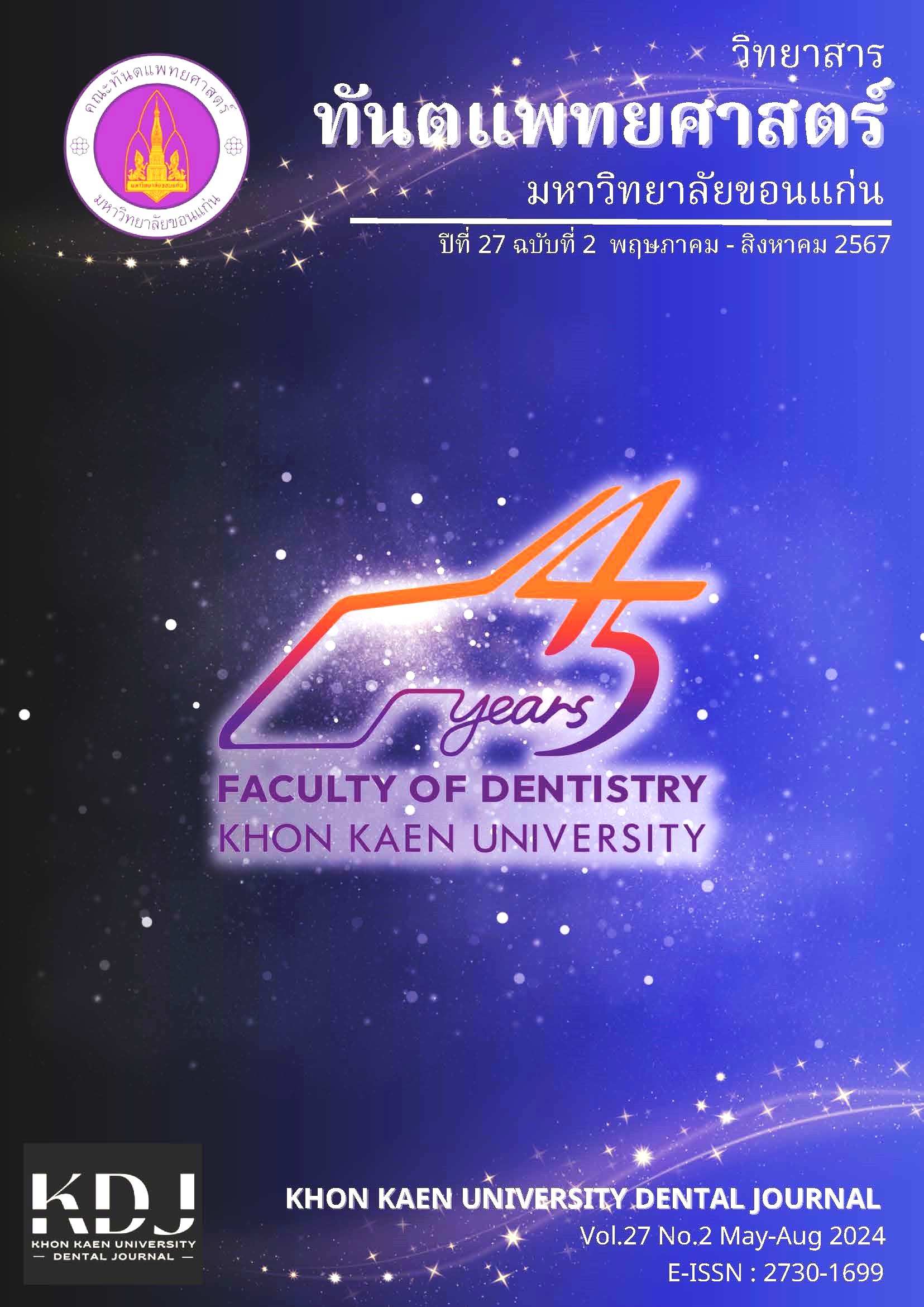ความสามารถในการไหลแทรกของวัสดุพิมพ์แบบอีลาสโทเมอร์ในแบบจำลองเสมือนจริงที่มีความกว้างร่องเหงือกที่แตกต่างกัน
Main Article Content
บทคัดย่อ
ไวนิลโพลีอีเทอร์ไซลอกเซนเป็นวัสดุชนิดใหม่ที่ถูกพัฒนาขึ้นโดยเป็นการรวมกันของวัสดุพิมพ์แบบโพลีอีเทอร์ และโพลีไวนิลไซลอกเซน ดังนั้นข้อมูลเกี่ยวกับการไหลแทรกเมื่อเปรียบเทียบกับวัสดุพิมพ์แบบอีลาสโตเมอริกชนิดอื่นยังคงมีไม่มากนัก โดยเฉพาะในแบบจำลองการศึกษาที่ใกล้เคียงกับสภาพในช่องปาก การศึกษานี้มีวัตถุประสงค์เพื่อประเมินและเปรียบเทียบความสามารถในการไหลแทรกของวัสดุพิมพ์แบบ ไวนิลโพลิอีเทอร์ไซลอกเซน ซอฟท์โพลีอีเทอร์ โพลิไวนิลไซลอกเซนที่ชอบน้ำ และโพลิไวนิลไซลอกเซนที่ไม่ชอบน้ำ ในร่องเหงือกเสมือนจริงที่มีความกว้างแตกต่างกัน 3 ขนาด เตรียมรอยพิมพ์จากแบบจำลองร่องเหงือกเสมือนจริงที่มีความกว้างร่องเหงือก 0.1 0.2 และ 0.4 มิลลิเมตรด้วยวัสดุพิมพ์แบบอีลาสโทเมอร์ 4 ชนิด โดยใช้เทคนิคการพิมพ์วัสดุพิมพ์ชนิดหนืดมากและชนิดหนืดน้อย 1 ขั้นตอน รอยพิมพ์แต่ละชิ้นถูกนำมาตัดแต่งตามแนวดิ่งออกเป็น 4 ส่วนแล้วนำไปวัดค่าความลึกการไหลแทรกโดยใช้กล้องจุลทรรศน์วัดระยะชิ้นงานแต่ละส่วนเริ่มจากเส้นสิ้นสุดเป็นจุดอ้างอิงในการวัด ข้อมูลถูกนำมาวิเคราะห์ด้วยสถิติเชิงพรรณนาและใช้สถิติการวิเคราะห์ความแปรปรวนแบบสองทาง ผลการศึกษาพบว่ามีอิทธิพลร่วมระหว่างขนาดความกว้างร่องเหงือกและชนิดของวัสดุพิมพ์ต่อความสามารถในการไหลแทรกของวัสดุพิมพ์อย่างมีนัยสำคัญทางสถิติ ไวนิลโพลิอีเทอร์ไซลอกเซนและซอฟท์โพลีอีเทอร์แสดงค่าการไหลแทรกที่มากกว่ากลุ่มโพลิไวนิลไซลอกเซนอย่างมีนัยสำคัญทางสถิติ ขณะที่ไม่มีความแตกต่างระหว่างกลุ่มไวนิลโพลิอีเทอร์ไซลอกเซนและกลุ่มซอฟท์โพลีอีเทอร์ เมื่อร่องเหงือกมีความกว้าง 0.4 และ 0.2 มิลลิเมตร อย่างไรก็ตาม ที่ความกว้างร่องเหงือก 0.1 มิลลิเมตร ไวนิลโพลิอีเทอร์ไซลอกเซนมีการไหลแทรกได้ลึกกว่าวัสดุพิมพ์ชนิดอื่นอย่างมีนัยสำคัญ กล่าวโดยสรุปได้ว่า ความสามารถในการไหลแทรกของวัสดุพิมพ์ในร่องเหงือกที่กว้างมีมากกว่าร่องเหงือกที่แคบ ไวนิลโพลิอีเทอร์ไซลอกเซนเผยให้เห็นว่ามีการลอกเลียนแบบได้ดีในทุกความกว้างของร่องเหงือก
Article Details

อนุญาตภายใต้เงื่อนไข Creative Commons Attribution-NonCommercial-NoDerivatives 4.0 International License.
บทความ ข้อมูล เนื้อหา รูปภาพ ฯลฯ ทีได้รับการลงตีพิมพ์ในวิทยาสารทันตแพทยศาสตร์ มหาวิทยาลัยขอนแก่นถือเป็นลิขสิทธิ์เฉพาะของคณะทันตแพทยศาสตร์ มหาวิทยาลัยขอนแก่น หากบุคคลหรือหน่วยงานใดต้องการนำทั้งหมดหรือส่วนหนึ่งส่วนใดไปเผยแพร่ต่อหรือเพื่อกระทำการใด ๆ จะต้องได้รับอนุญาตเป็นลายลักษณ์อักษร จากคณะทันตแพทยศาสตร์ มหาวิทยาลัยขอนแก่นก่อนเท่านั้น
เอกสารอ้างอิง
Rosenstiel SF, Land MF, Fujimoto J. Contemporary fixed prosthodontics. 4thed. St.Louis: Mosby Elsevie; 2006. 217-8.
Aimjirakul N. Prevalence of finishing line location of prepared teeth for cast post and cores and types of previous restoration. J Dent Assoc Thai 2009;59(1):22-8.
Massari C, Anfe ATE, Caneppele TMF, Agra CM. Gingival retraction: thickness measurement and comparison of different cords. Braz Dent Sci 2015;18(2):50-7.
Donovan TE, Gandara BK, Nemetz H. Review and survey of medicaments used with gingival retraction cords. J Prosthet Dent. 1985;53(4):525-31.
Prasanna GS, Reddy K, Kumar RK, Shivaprakash S. Evaluation of efficacy of different gingival displacement materials on gingival sulcus width. J Contemp Dent Pract. 2013;14(2):217-21.
Raghav D, Singh S, Kola MZ, Shah AH, Khalil HS, Kumar P. A comparative clinical and quantitative evaluation of the efficacy of conventional and recent gingival retraction systems: an in vitro study. Eur J Prosthodont. 2014;2(3):76-81.
Laufer BZ, Baharav H, Ganor Y, Cardash HS. The effect of marginal thickness on the distortion of different impression materials. J Prosthet Dent. 1996;76(5):466-71.
Laufer BZ, Baharav H, Cardash HS. The linear accuracy of impressions and stone dies as affected by the thickness of the impression margin. Int J Prosthodont 1994; 7(3):247-52.
Laufer BZ, Baharav H, Langer Y, Cardash HS. The closure of the gingival crevice following gingival retraction for impression making. J Oral Rehabil 1997;24(9):629-35.
Page RC, Ammons WF, Schectman LR, Dillingham LA. Collagen fibre bundles of the normal marginal g-ngiva in the marmoset. Arch Oral Biol. 1974;19(11):1039-43.
Mandikos MN. Polyvinyl siloxane impression materials: an update on clinical use. Aust Dent J. 1998;43(6):428-34.
Hamalian TA, Nasr E, Chidiac JJ. Impression materials in fixed prosthodontics: influence of choice on clinical procedure. J Prosthodont. 2011;20(2):153-60.
Perakis N, Belser UC, Magne P. Final impressions: a review of material properties and description of a current technique. Int J Periodontics Restorative Dent 2004; 24(2):109-17.
Shetty RM, Bhandari GR, Mehta D. Vinyl polysiloxane ether: a breakthrough in elastomeric impression material. World J Dent 2014;5(2):134-7.
Stober T, Johnson GH, Schmitter M. Accuracy of the newly formulated vinyl siloxanether elastomeric impression material. J Prosthet Dent 2010;103(4):228-39.
Finger WJ, Kurokawa R, Takahashi H, Komatsu M. Sulcus reproduction with elastomeric impression materials: a new in vitro testing method. Dent Mater 2008;24(12):1655-60.
Khatri M, Mantri SS, Deogade SC, Bhasin A, Mantri S, Khatri N, Jain P, Chauhan D. Effect of chemical disinfection on surface detail reproduction and dimensional stability of a new vinyl polyether silicone elastomeric impression material. Contemp Clin Dent 2020;11(1):10-14.
Goldberg PV, Higginbottom FL, Wilson TG. Periodontal considerations in restorative and implant therapy. Periodontol 2000 2001;25:100-9.
Madhok S, Rajput G, Singh G. Non-surgical gingival retraction past and current trends. Guident 2014; 7(11):26-30.
Takahashi H, Finger WJ, Kurokawa R, Furukawa M, Komatsu M. Sulcus depth reproduction with polyvinyl siloxane impression material: effects of hydrophilicity and impression temperature. Quintessence Int 2010; 41(3):e43-50.
German MJ, Carrick TE, McCabe JF. Surface detail reproduction of elastomeric impression materials related to rheological properties. Dent Mater 2008;24(7):951-6.
Lawson NC, Cakir D, Ramp L, Burgess JO. Flow profile of regular and fast-setting elastomeric impression materials using a shark fin testing device. J Esthet Restor Dent 2011;23(3):171-6.
McCabe JF, Arikawa H. Rheological properties of elastomeric impression materials before and during setting. J Dent Res 1998;77(11):1874-80.
Lee DY, Oh YI, Chung KH, Kim KM, Kim KN. Mechanism study on surface activation of surfactant-modified polyvinylsiloxane impression materials. J Appl Polym Sci 2004;92(4):2395-401.
Pratten DH, Craig RG. Wettability of a hydrophilic addition silicone impression material. J Prosthet Dent 1989;61(2):197-202.
Vassilakos N, Fernandes CP. Surface properties of elastomeric impression materials. J Dent 1993;21(5): 297-301.
Kettenbach. Product guideline Identium: 2018. Available from: https://www.kettenbach-dental.com/products/impression-material/identium.
Balkenhol M, Eichhorn M, Wostmann B. Contact angles of contemporary type 3 impression materials. Int J Prosthodont. 2009 Jul-Aug;22(4):396-8.
Menees TS, Radhakrishnan R, Ramp LC, Burgess JO, Lawson NC. Contact angle of unset elastomeric impression materials. J Prosthet Dent 2015;114(4):536-42.


